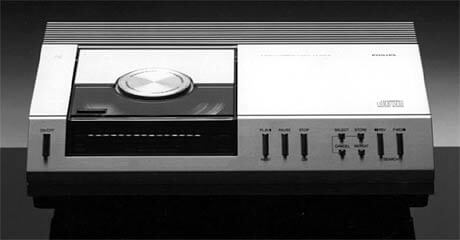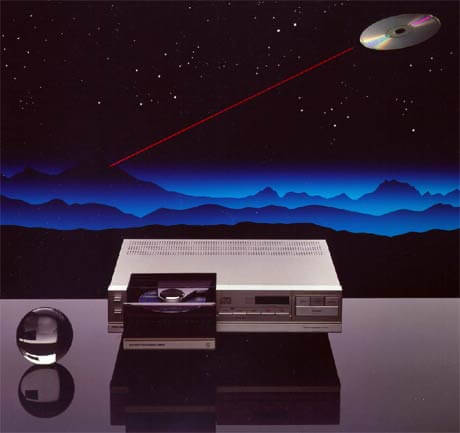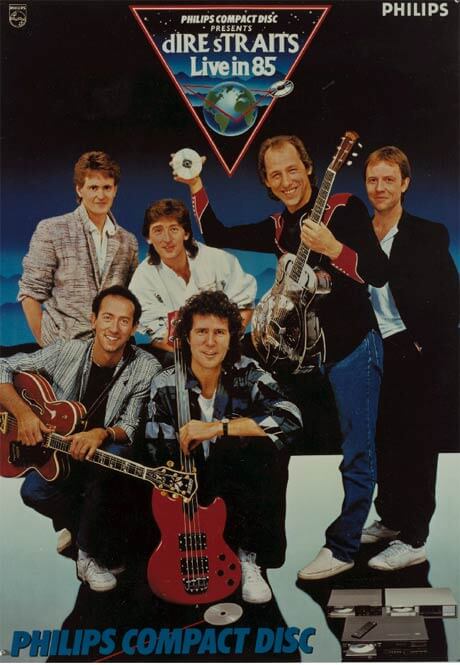Philips CD 25 year anniversary
Philips celebrates 25th anniversary of the compact disc
On August 17, 1982 at a factory outside Hanover, Germany the Compact Disc was born - and that means that the CD is celebrating it’s 25th birthday today! We got a nice press kit from Philips (inventors of the CD) and we’re sharing it with you guys inside.
Amsterdam, The Netherlands – Exactly 25 years ago tomorrow, on August 17, 1982, Royal Philips Electronics (NYSE:PHG, AEX:PHI) manufactured the world’s first Compact Disc at a Philips factory in Langenhagen, just outside of Hanover, Germany. The invention of the CD ushered in a technological revolution in the music industry as CDs – with their superior sound quality and scratch free durability – marked the beginning of the shift from analogue to digital music technology. The CD became a catalyst for further innovation in digital entertainment, helping pave the way for the launch of DVD and the current introduction of Blu-ray optical media. Having played a key role in the innovation of digital music, at home and on the move, consumers continue to witness huge advances in entertainment and lifestyle technologies.

First CD player from Philips.
The Philips factory in Germany, where the world’s first CD was pressed, belonged to Polygram – the recording company, which Philips owned at the time. The first CD to be manufactured at the plant was “The Visitors” by ABBA. By the time CDs were introduced on the market in November 1982, a catalogue of around 150 titles – mainly classical music – had been produced. The first CDs and CD players – including Philips’ CD100 – were introduced in Japan in November, followed by a US and European market introduction in March of 1983.
Philips and Sony partnered to develop CD – collaboration based on open innovation helped position CD as standard for the music industry
As early as 1979, Philips and Sony set up a joint task force of engineers to design the new digital audio disc. Many decisions were made in the year to follow – such as the disc diameter. The original target storage capacity for a CD was one hour of audio content, and a disc diameter of 115 mm was sufficient for this, however both parties extended the capacity to 74 minutes to accommodate a complete performance of Beethoven’s 9th Symphony. In June 1980, the new standard was proposed by Philips and Sony as the “Red Book” containing all the technical specification for all CD and CD-Rom standards.

Piet Kramer, who at the time was a member of the optical group at Philips that made a significant contribution to the CD technology, commented on Philips’ and Sony’s collaborative work: “When Philips teamed up with Sony to develop the CD, our first target was to win over the world for the CD. We did this by collaborating openly to agree on a new standard. For Philips, this open innovation was a new approach – and it paid off. In the late 70s and early 80s, we never imagined that one day the computing and entertainment industries would also opt for the digital CD for storing the growing volume of data for computer programs and movies.” In 1985, Philips and Dire Straits team up to promote the Compact Disc
As music industry sales of CDs started to take off in 1983, more than 1000 different titles were on the market. In 1985, one of the most famous bands in the world, Dire Straits, adopted the CD. The infamous album “Brothers in Arms”, as one of the first fully digital recording (DDD) to be brought to market, went on to become the top selling CD at the time, and the third greatest selling CD of the decade. The joint collaboration with Philips entailed Philips and Dire Straits jointly promoting the sound quality of the CD to consumers, making “Brothers in Arms” the first album to sell over one million copies in this new format, marking the success of the CD as the emerging format of choice for music quality.
“The Compact Disc has proven its significance in bringing the highest quality of music to consumers who wish to enjoy scratch free music. The enormous success of the CD over the last twenty-five years has opened many new opportunities for consumers to make the most of their music at home and on the move,” said Lucas Covers, Senior Vice President & Chief Marketing Officer, Philips Consumer Electronics. “It has played a pivotal role in the shift from analogue music to digital, not least for the DVD as well in music, though moreover in helping lay the foundation for even new technologies such as Blu-ray quality today,” he added. Over 200 billion CDs have been sold worldwide over the past 25 years

1985 was the year that one of the most famous bands in the world, Dire Straits, adopted the CD. The joint collaboration with Philips entailed Philips and Dire Straits jointly promoting the sound quality of the CD to consumers, making “Brothers in Arms” the first album to sell over one million copies in this new format, marking the success of the CD as the emerging format of choice for music quality.
The Compact Disc, is the forefather of today’s extensive family of optical discs for a wide range of applications such as CD-Rom, CD-R and CD-RW, DVD, DVD R, DVD RW and Blu-ray. Philips estimates that over the past 25 years, since the first CD was pressed at the Philips factory near Hanover, Germany, over 200 billion CDs have been sold worldwide. Even though a single CD is only 1.2 mm thick, if all CDs ever produced were piled up, the stack of CDs would circle the earth six times. The compact disc, as well as the DVD disc, remain a very popular music/ video carrier, because of their digital quality, portability, and resilience to damage, and remain a very popular gift.
The idea for the CD Options
Unfortunately, the inventor of the CD does not exist. Nobody even invented one part of the technology alone. The CD was invented collectively by a large group of people working as a team. Emil Berliner, the founder of Deutsche Grammophon, might have been able to invent the gramophone record on his own in 1887, but the technology on which the CD is based is too complex for just one genius. "We needed all the skills that you would find in a large lab," says Piet Kramer, who at the time was head of the optical group that made a significant contribution to the CD technology. "Electronics engineers, photographic experts, mechanical engineers, control engineers, you have to bring all of these experts together, and then look to see if it can be done." The pooling of creativity like this is typical of the way in which technological progress is made nowadays.
When the Philips researchers started to work on the VLP in about 1970, almost immediately they came up with the idea to use the same technology to record sound. The use of laser technology in particular seemed an attractive prospect. The new way to play music would no longer suffer from wear. Furthermore, in theory it would be possible to achieve a better sound quality, in particular for the treble, for it is precisely in rapid movements that the limitations of the needle of a record player become apparent.
It started off as a modest project. The similarities with the VLP meant that the idea could be worked on with relatively little effort. The research group at Philips Research Laboratories consisted of only two men: Loek Boonstra and Toon van Alem.
The audio version of the VLP would be able to benefit from the new technology that had been developed for the video disc. Perhaps it would even be possible to use the same player. In this way, an attractive new medium could be developed in the footsteps of the VLP. In order to highlight the similarities, the new sound medium was soon named Audio Long Play (ALP).
For a long time it was precisely this conscious use of analogies with the VLP that prevented the launch of a new sound medium. It started with the idea that the VLP and the ALP should resemble each other externally. This was beneficial from a marketing point of view. It meant there would be no need for an additional item of equipment in the living room to replace the record player. The idea was studied, but the market opportunities were considered to be poor. An ALP with an average diameter of thirty centimeters, the same size as the VLP and the LP, would be able to hold dozens of hours of music. Which consumer would want that? And what record company would want to sell so much music on just one disc? An ALP that is as big as a VLP would have the survival chances of a dinosaur. Such an audio disc would collapse under the weight of the colossal playing time.
Lou Ottens, technical director of the audio division at Philips, was one of the first to take the logical step. He realized that this dilemma could only be solved by reducing the size of the ALP. With hindsight, this might seem an insignificant idea, but it meant more direct competition with the unassailable success of the black vinyl.
Lou Ottens worked as a member of the management team of the audio division itself and therefore not at Philips Research Laboratories. The small group of researchers who were carrying out research into the ALP at Philips Research Laboratories were however on the payroll of the audio division. Without the vision that Ottens put forward, the CD would never have come into being. He realized that the music that was currently being brought out on LP would soon have to be made available on an ALP. The playing time therefore had to be approximately one hour, Ottens thought. The diameter of the new audio disc would then have to be about 10 centimeters because, above all, the ALP had to be more practical and convenient than the gramophone record. Ottens was fanatical when it came to user-friendliness. After all, he had been closely involved in the development of the Compact Cassette in the sixties. And within Philips he frequently became angry about clumsy consumer products.
The smaller ALP would still be able to benefit from technical analogies with the VLP. By using the same coding technique, much of the electronics would be the same in the two types of equipment. Furthermore, the coding technique tied in surprisingly well with a new trend that was emerging in the seventies: quadraphony. At that time, broadcasting corporations were starting to broadcast music with four-channel sound, giving a more complete reproduction than stereo broadcasts. Two speakers in front of the listener and two behind together created the sensation of being in a concert hall.
It turned out that quadraphony could be recorded much more effectively on an ALP than on an LP. After all, different signals had to be combined on the VLP in order to record video images. The combination of four separate sound channels was therefore well within the possibilities. Quadraphony would give the ALP something more than the LP, for the quadraphonic version of the LP had to make the most of the possibilities created by the two sides of a groove. The two additional channels for quadraphony could only be put on an LP using a number of technical tricks — with only moderate results.
With these thoughts in mind, work on the ALP was continued by a team that now comprised four researchers at Philips Research Laboratories. For the time being it remained a project of modest scope. In 1974 the first prototype of an ALP was ready to be shown to a number of insiders. Gradually it became clear that quadraphony did not provide the opportunities that had been hoped for. A disc with one hour of four-channel music would need to have a diameter of 20 centimeters, i.e. larger than the requirements set by Ottens. Furthermore, the quadraphonic trend did not really take off. The ALP therefore had to become stereo, just like the LP. The medium would only be able to distinguish itself from the black vinyl by its compactness and superior sound quality.
At the first demonstrations the actual sound quality was disappointing. The use of contactless laser scanning meant that there was no scratching or ticking noise from a needle. However, the music reproduction was hampered by crackle and creak.
This was caused by the coding technique used. As a result of errors that occurred during the pressing of the disc, it was difficult for the laser to follow the pit track. This did not really matter when video images were being reproduced because the eye is too slow to notice if there is a picture line missing. However, if the music is missing for a moment, the ear detects that straight away. The technology that had been borrowed from the VLP therefore proved ultimately not to be suitable for sound.
It was not only the imperfections in the surface that caused trouble for the ALP. The use of analog coding on the disc meant there was a direct relation between the way in which the sound was played back and the quality of the sound. Irregularities in the number of revolutions are translated directly into variations in the pitch, just as in the case of the LP. When the signal is amplified, the ALP suffers just as much from noise as the LP. As a result, the ALP had little more to offer than the LP.
Now it was clear that the required sound quality could not be achieved using the analog technology, new coding techniques had to be found. A number of technological analogies with the video disc had now disappeared. Would the ALP be able to make it alone now that the technological choices that had been developed for the VLP could no longer be followed? The development team, which had just been expanded by the addition of a fifth person, would have to grow substantially in order to research the new digital techniques. This would cause the development costs to rise sharply.
Ottens had a slightly unusual approach to costs: if you can just manage to sell enough products, ultimately it is only the material costs that count. He referred to this as the first law of consumer electronics (the second related to introduction on the market). The thing to do, he thought, was to make the ALP as compact as possible so that it did not require much material at all. He predicted two developments that would make the player even smaller. Until then extensive electronics had been required for the ALP, but new technologies were emerging which would enable many components to be integrated on one piece of silicon.
The second development related to a new type of laser. Endeavours to manufacture lasers with semiconductors instead of large gas tubes had met with success. The first attempts to make compact solid-state lasers date back to the seventies. The structures that were required to achieve the laser effect were etched away in a small piece of material comparable with a chip. These first prototypes were not very successful. They worked for a few seconds and then after that the material became too hot and burst apart.
Piet Kramer, head of the optical group, did not therefore hold out much hope for the solid-state laser. Ottens had great hopes that progress would continue to be made in the improvement of the laser and the miniaturization of electronics. At that time the components in question were still fairly exotic. ‘But a solid state laser is such a tiny piece of material. It can’t be expensive. There is nothing in it that is really expensive,’ thought Ottens. He viewed the expensive optical system in the ALP players in the same straightforward way. It is made of glass, nothing more than that. The expensive research and complex machinery no longer count in mass production. What matters then is what material you use.
Ottens calculated that it need not cost any more than 150 guilders (about 75 Euros) to produce an ALP player — that was less than most record players cost at that time. Looking back, it is clear that his estimate was on the conservative side. Now, almost a quarter of a century later, the production costs of some CD players amount to no more than a few dozen guilders.
In 1977, Ottens managed to generate great enthusiasm amongst Philips’ senior management with his calculations. What had until then been a small project, which had followed in the tracks of the video disc, now became an independent one. A separate development lab was set up for the sound disc within the audio division. Joop van Tilburg, who had then just been appointed general manager of the audio division, felt that the product should therefore be given a new name. There were a number of different proposals: Minirack, Mini Disc, Compact Rack, but it was to be Compact Disc, for Van Tilburg wanted it to remind people of the success of the Compact Cassette. This brought the CD out of the shadow of its predecessor, the video disc.